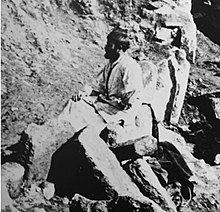Panagiotis Stamatakis | |
|---|---|
Παναγιώτης Σταµατάκης | |
 The only conjectured photograph of Stamatakis, taken during the excavation of Grave Circle A at Mycenae in 1876.[a] | |
| Born | Panagiotis Antoniou Stamatakis c. 1835 Varvitsa, Laconia, Greece |
| Died | 31 March [O.S. 19 March] 1885 (aged c. 50) Piraeus, Athens |
| Occupation | Archaeologist |
| Known for | Excavations around Greece, particularly at Mycenae |
| Title | Ephor General (1884–1885) |
| Signature | |
Panagiotis Antoniou Stamatakis (Greek: Παναγιώτης Ἀντώνιου Σταµατάκης; c. 1835[b]–1885) (sometimes anglicised as Panayotis or Stamatakes) was a Greek archaeologist. He is noted particularly for his role in supervising the excavations of Heinrich Schliemann at Mycenae in 1876, and his role in recording and preserving the archaeological remains at the site.
Most of Stamatakis's early life is obscure: he was born in the village of Varvitsa in Laconia, and had no university education or formal archaeological training. He was hired as an employee of the Greek Ministry of Religious Affairs and Public Education in 1863, and recruited in 1866 as an assistant to Panagiotis Efstratiadis,[5] the Ephor General of Antiquities leading the Greek Archaeological Service. Over the following two decades, Stamatakis travelled and excavated widely throughout Greece. His major role was as a travelling official, or "apostle", working variously for the Archaeological Service and the Archaeological Society of Athens: in this capacity, he investigated antiquities crimes and founded museum collections throughout Greece. He was particularly prolific in the region of Boeotia, where he excavated at Tanagra, at Chaeronea and Thespiai, and established the Archaeological Museum of Thebes.
Between 1876 and 1877, Stamatakis was deputised by Efstratiadis to represent the Greek government and the Archaeological Society at the excavations of Mycenae, which were being conducted by Heinrich Schliemann on the society's behalf. Both Stamatakis and Efstratiadis distrusted Schliemann's integrity, and Stamatakis frequently opposed Schliemann's methodology, which paid little attention to accurate record-keeping or to the preservation of cultural material Schliemann deemed uninteresting. After Schliemann's departure from Mycenae late in 1876, Stamatakis discovered additional tombs at the site, completed the excavation and organised the public exhibition of its finds.
Stamatakis was promoted to Ephor General in 1884. After his premature death in 1885, his work was largely forgotten, and most of his excavations remained unpublished.[c] Modern reassessment of the excavations at Mycenae, fuelled in large part by the rediscovery in the early 21st century of Stamatakis's notebooks from the site, led in turn to a re-evaluation of his importance to the Mycenae excavations and to Greek archaeology: he has been described as "one of the great Greek archaeologists of the nineteenth century".[7]
- ^ Konstantinidi-Syvridi & Paschalidis 2019, p. 112.
- ^ Petrakos 2022, p. 32.
- ^ Traill 2012, p. 79.
- ^ Petrakos 2005, p. 117.
- ^ Konstantinidi-Syvridi 2020, p. 277.
- ^ Prag et al. 2009, p. 234.
- ^ Traill 2012, p. 84.
Cite error: There are <ref group=lower-alpha> tags or {{efn}} templates on this page, but the references will not show without a {{reflist|group=lower-alpha}} template or {{notelist}} template (see the help page).